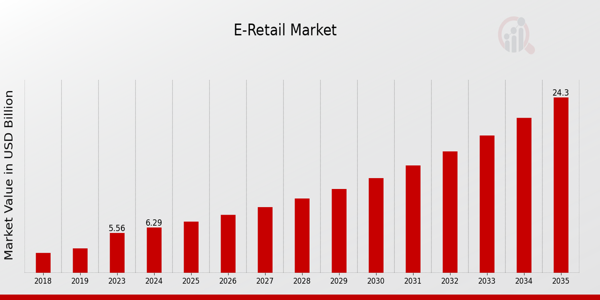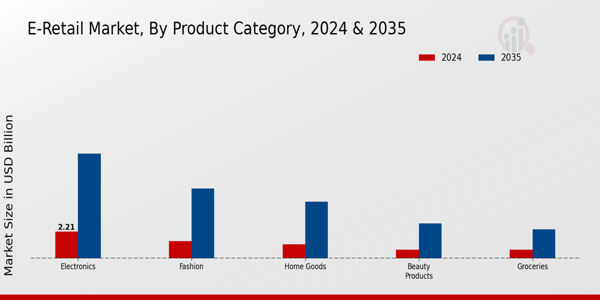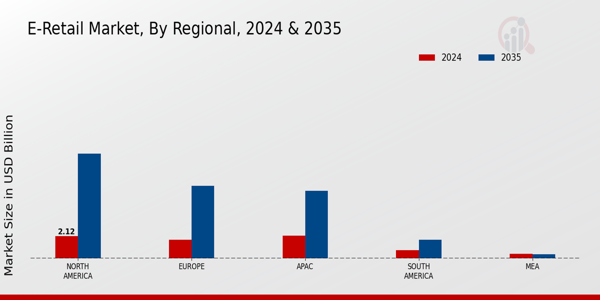Global E-Retail Market Overview
E-Retail Market Size was estimated at 5.56 (USD Billion) in 2023. The E-Retail Market Industry is expected to grow from 6.29(USD Billion) in 2024 to 24.3 (USD Billion) by 2035. The E-Retail Market CAGR (growth rate) is expected to be around 13.08% during the forecast period (2025 - 2035).

Source: Primary Research, Secondary Research, MRFR Database and Analyst Review
Key E-Retail Market Trends Highlighted
The E-Retail Market is witnessing significant growth driven by increasing internet penetration and the rising use of smartphones. With more consumers choosing the convenience of online shopping, the demand for a seamless and engaging shopping experience is on the rise. This shift has encouraged retailers to invest in advanced technologies like artificial intelligence and augmented reality to enhance customer interaction. Additionally, social media platforms have become vital for promoting products and reaching wider audiences, further boosting online sales. There are numerous opportunities in the e-retail space that are ripe for exploration.The technological growth in last-mile delivery services has introduced an opportunity for businesses to enhance their customer satisfaction through timely and consistent shipment. To add on, the use of personalized marketing tools can assist in enhancing the overall experience of individual shoppers and cultivating customer loyalty through repeat purchases. The effective incorporation of eco-friendly policies in supply chain management is another area as the consumers' concern for environmental sustainability increases. Eco-conscious retailing could allow firms to emerge stronger competitive advantage. Current insights show the evolution towards an omnichannel fashion of selling, which combines Internet and brick-and-mortar shopping.
This comprehensively meets consumers' needs for different modes of purchasing products, either by providing a click-and-collect service or being able to return items bought from the internet or the shop. The use of such subscription-based models is also increasing as they enable ease of access and tailoring of services. Besides, social commerce is becoming more common, revealing the growing preference for shopping through social networks succinctly, which facilitates impulse buying and engages consumers. By and large, the development of the E-Retail Market is multifaceted, with a large number of factors affecting its growth.
E-Retail Market Drivers
Rising Internet Penetration and Smartphone Usage
The E-Retail Market Industry is significantly benefiting from the rise in internet penetration and the growing usage of smartphones. As more individuals gain access to the internet, likely facilitated by affordable data plans and improved connectivity, the opportunity for online retail transactions increases exponentially. Today, consumers can shop anytime and anywhere, thanks to mobile technology, which allows for a seamless shopping experience.This trend has encouraged businesses to invest in mobile-friendly platforms to attract users. In conjunction with the increasing reliance on smartphones, the convenience offered by e-retail platforms enhances customer engagement and drives sales. As consumer preferences shift towards online shopping, the adoption of digital payment methods and secure online transactions further eases concerns about safety, thus creating a robust landscape for the growth of the E-Retail Market Industry.Furthermore, technology advancements lead to improved user experiences, with features like personalized recommendations, easy navigation, and faster checkout processes. This transformation in shopping behavior, propelled by technological improvements, positions the E-Retail Market Industry for significant growth in the coming years.
Evolution of Consumer Behavior
The E-Retail Market Industry is experiencing a seismic shift in consumer behavior, which acts as a crucial market driver. The modern consumer is increasingly looking for convenience, variety, and competitive pricing offered by online ventures. This burgeoning expectation compels retailers to adapt by enhancing their digital offerings and streamlining logistics operations, which ultimately attracts a broader base of customers. Shoppers today are more informed and selective, leveraging online reviews and price comparisons, driving e-retailers to optimize their service and product portfolios.Brands that effectively engage with this evolving consumer mindset are likely to thrive in the dynamic E-Retail Market Industry.
Growth of Social Media and Influencer Marketing
Social media platforms have become an essential part of e-retail strategies, significantly impacting the E-Retail Market Industry. With billions of users engaging daily on platforms like Instagram, Facebook, and TikTok, retailers leverage these channels to reach a wider audience. Social media not only serves as a marketing tool but also facilitates direct interactions with customers, enabling personalized promotions and direct feedback. The rise of influencer marketing has further propelled this trend, where recommendations from influencers can drive significant traffic and sales for e-retailers.By aligning with trusted personalities, brands can enhance their credibility and foster loyalty among consumers, ultimately contributing to the growth of the E-Retail Market Industry.
E-Retail Market Segment Insights
E-Retail Market Product Category Insights
The E-Retail Market has experienced significant development and diversification in its Product Category segment. By 2024, the market is expected to reach a valuation of approximately 6.29 USD Billion, showcasing a robust growth potential influenced by shifting consumer behaviors and technological advancements. The segmentation within the E-Retail Market includes key categories such as Electronics, Fashion, Home Goods, Beauty Products, and Groceries, each contributing distinct dynamics to the overall landscape. Among these, Electronics stands out with a valuation projected at 2.21 USD Billion in 2024, expanding to 8.65 USD Billion by 2035, thereby dominating the market due to the continuous demand for innovative gadgets and devices, which reflects society's growing dependence on technology.Fashion holds a significant position as well, expected to be valued at 1.45 USD Billion in 2024 and rising to 5.78 USD Billion in 2035. The prominence of this category is largely driven by changing fashion trends and the rise of online shopping, especially with demographic groups inclined toward fast and convenient access to the latest styles. Home Goods is also a compelling segment, valued at 1.17 USD Billion in 2024 with a growth trajectory leading to 4.67 USD Billion in 2035. This reflects a greater consumer focus on home aesthetics and utility, particularly influenced by the work-from-home trend intensifying in recent years.The Beauty Products category, although valued at a lower 0.73 USD Billion in 2024, is expected to grow to 2.91 USD Billion by 2035, driven by increasing awareness of self-care and wellness among consumers, coupled with the effective use of social media for marketing beauty items. Lastly, the Groceries segment is uniquely positioned with an equal valuation to Beauty Products at 0.73 USD Billion for 2024, growing to 2.39 USD Billion by 2035; this growth shows a reflective increase in online grocery shopping as consumers prioritize convenience and efficient meal planning.The market growth of these segments is supported by evolving technology, logistical improvements, and shifting consumer priorities, which continually reshape the E-Retail Market Statistics. However, challenges such as intense competition, logistical issues, and ever-changing regulations pose significant hurdles. Nevertheless, opportunities abound within the digital landscape, providing ways for businesses to innovate and customize their services according to emerging consumer demands, thus further enhancing the E-Retail Market revenue in the Product Category segment.

Source: Primary Research, Secondary Research, MRFR Database and Analyst Review
E-Retail Market Sales Channel Insights
The E-Retail Market, valued at 6.29 billion USD in 2024, showcases a diverse array of sales channels that significantly influence its performance. Key channels include Mobile Applications, Websites, Social Media, and Marketplaces, each contributing uniquely to the market landscape. Mobile Applications have seen increasing popularity due to their convenience and user-friendly interfaces, making them a major channel for consumer engagement. Websites, historically the backbone of e-retail, continue to dominate, offering a comprehensive shopping experience.Social Media has emerged as a significant player, leveraging platforms for marketing and direct sales, thus enhancing brand visibility and customer interaction. Marketplaces represent a crucial avenue due to their extensive reach and variety, allowing sellers to access a broad audience. The continuous growth in these channels reflects shifting consumer behaviors and preferences toward online shopping, significantly impacting E-Retail Market revenue. As these sales channels evolve, they create opportunities for innovative approaches in customer acquisition, engagement, and retention while also presenting challenges such as competition and technological advancements that need addressing.Overall, the E-Retail Market segmentation through sales channels presents vital insights into current trends, growth drivers, and the dynamics shaping the industry landscape.
E-Retail Market Customer Type Insights
The E-Retail Market revenue is poised to reach 6.29 billion USD by 2024, showcasing a robust growth trajectory. Within this market, the Customer Type segmentation plays a pivotal role, encompassing Individual Consumers, Business Consumers, and Bulk Buyers. Individual Consumers dominate the market due to the growing trend of online shopping, where convenience and a wider selection of products cater to their needs. Business Consumers follow closely, benefiting from the consistent demand for office supplies and services, which continues to expand as businesses increasingly shift towards e-commerce platforms.Bulk Buyers, while a smaller segment, contribute significantly by taking advantage of wholesale prices and exclusive deals, reflecting a strategic approach to procurement in a digital landscape. Trends such as personalized shopping experiences and the adoption of mobile commerce further bolster the E-Retail Market statistics, creating a favorable environment for all customer types. Challenges, including cybersecurity concerns and competition among e-retailers, persist, yet opportunities arise through the integration of advanced technologies, enhancing user shopping experiences and driving further growth in this evolving market.
E-Retail Market Payment Method Insights
The E-Retail Market, particularly within the Payment Method segment, is experiencing notable growth, with the overall market valued at 6.29 billion USD in 2024 and projected to expand significantly by 2035. This segment encompasses various payment options, including Credit Cards, Digital Wallets, Bank transfers, and Cash on Delivery, each playing a crucial role in driving consumer behavior in online shopping. Credit cards remain a leading choice for many due to their convenience and security, influencing a majority of transactions. Meanwhile, Digital Wallets are gaining traction, reflecting a shift towards mobile and contactless solutions that cater to tech-savvy consumers.Bank Transfers, though traditionally slower, are becoming more efficient with advancements in technology, making them a viable option for larger purchases. Cash on Delivery continues to hold a significant position, particularly in regions where online payment adoption is lower, serving as a trust-building mechanism for e-retailers. The evolving preferences within the E-Retail Market revenue landscape emphasize the importance of diverse payment methods and their role in meeting consumer needs, ultimately supporting market growth and shaping industry trends.
E-Retail Market Regional Insights
The E-Retail Market revenue is expected to experience significant growth across various regions, with North America holding a majority position valued at 2.12 USD Billion in 2024, projected to rise to 9.93 USD Billion by 2035. This regional dominance is attributed to advanced technology adoption and high consumer spending. Europe follows closely with a valuation of 1.77 USD Billion in 2024, expected to grow to 6.88 USD Billion, showcasing the increasing trend of online shopping among European consumers. The APAC region also demonstrates notable growth, initially worth 2.15 USD Billion in 2024 and forecasted to reach 6.4 USD Billion by 2035, driven by a large population and rapidly expanding internet access.South America and MEA signify smaller markets in comparison, with South America valued at 0.81 USD Billion in 2024 and projected to grow to 1.77 USD Billion, while MEA's valuation declined slightly from 0.44 USD Billion in 2024 to 0.42 USD Billion in 2035. Despite their lower revenue figures, these regions present opportunities for future expansion as e-retail gains popularity. Overall, the E-Retail Market segmentation showcases varied dynamics driven by consumer behavior, technological advancements, and accessibility trends across different geographies.

Source: Primary Research, Secondary Research, MRFR Database and Analyst Review
E-Retail Market Key Players and Competitive Insights:
The competitive insights of the E-Retail Market reveal an increasingly dynamic landscape where numerous players strive to establish their presence and capture consumer attention. The market is characterized by rapid technological advancements, evolving consumer preferences, and a surge in online shopping, which have reshaped traditional retail paradigms. With the ongoing shift toward digital channels, companies are employing diverse strategies to gain a competitive edge. This includes enhancing user experiences, leveraging data analytics for personalized marketing, and expanding their product offerings. The integration of artificial intelligence and machine learning technologies is also becoming prevalent, helping businesses forecast trends and cater to their target demographics effectively. In this competitive arena, understanding market trends and consumer behavior is paramount for sustained growth and the ability to outperform rivals.Shopify has carved out a significant niche within the E-Retail Market, positioned as a robust platform enabling merchants to create their online stores with relative ease. Its strength lies in its comprehensive suite of tools aimed at facilitating e-commerce, thereby empowering small to medium-sized enterprises to compete effectively with larger retailers. Shopify offers scalability and adaptability, suiting the varying needs of businesses at different growth stages. The platform is also well-regarded for its user-friendly interface and extensive customizability. Its focus on integrating with multiple sales channels, including social media and online marketplaces, enhances its value proposition for retailers looking to diversify their sales strategies. By continuously introducing innovative features and optimizing customer support, Shopify has established a strong market presence, fostering loyalty among its user base.Walmart is another formidable player in the E-Retail Market, leveraging its extensive physical infrastructure to enhance its online presence. The company adopts an omnichannel approach, which integrates online shopping with its brick-and-mortar operations, creating a seamless shopping experience for customers. Walmart's competitive advantages include a vast product range, competitive pricing strategies, and the convenience of same-day delivery services. The retailer invests heavily in technology and logistics to improve its e-commerce capabilities, reflecting its commitment to maintaining a strong position in the digital marketplace. Walmart's strategic partnerships and acquisition of technology startups have further bolstered its ability to adapt to changing consumer expectations and market dynamics. By prioritizing customer experience and accessibility, Walmart continues to assert itself as a key contender in the evolving landscape of global e-retailing.
Key Companies in the E-Retail Market Include:
- Shopify
- Walmart
- Best Buy
- Flipkart
- Alibaba
- Rakuten
- Costco
- Sainsbury's
- eBay
- com
- Argos
- Amazon
- Target
- Otto Group
- Zalando
E-Retail Market Industry Developments
The E-Retail Market is witnessing significant developments, with companies like Shopify and Amazon enhancing their platforms and services to cater to increasing consumer demands. Walmart has accelerated its e-commerce initiatives, optimizing supply chains and partnerships to enhance delivery capabilities. Meanwhile, Flipkart is expanding its reach in India through strategic collaborations and investments in technology. Alibaba continues to innovate with its marketplace and logistics services, reinforcing its dominance in Asia. Rakuten is exploring new technologies to improve customer experience, while Costco is boosting its online presence with membership offers to attract more customers. In terms of mergers and acquisitions, Best Buy has been active, looking at potential partnerships to enhance its online sales capabilities. JD.com is also evaluating strategic alliances to strengthen its position in the Chinese market. Growth in market valuation is evident, with eBay and Target reporting significant upticks as they adapt to changing consumer behaviors. The rapid advancements in e-retail technologies and the ongoing shifts in consumer preferences are shaping the competitive landscape, with major players continually innovating to secure their market share.
E-Retail Market Segmentation Insights
- E-Retail Market Product Category Outlook
- Electronics
- Fashion
- Home Goods
- Beauty Products
- Groceries
- E-Retail Market Sales Channel Outlook
- Mobile Applications
- Websites
- Social Media
- Marketplaces
- E-Retail Market Customer Type Outlook
- Individual Consumers
- Business Consumers
- Bulk Buyers
- E-Retail Market Payment Method Outlook
- Credit Card
- Digital Wallet
- Bank Transfer
- Cash on Delivery
| Report Attribute/Metric |
Details |
| Market Size 2023 |
5.56(USD Billion) |
| Market Size 2024 |
6.29(USD Billion) |
| Market Size 2035 |
24.3(USD Billion) |
| Compound Annual Growth Rate (CAGR) |
13.08% (2025 - 2035) |
| Report Coverage |
Revenue Forecast, Competitive Landscape, Growth Factors, and Trends |
| Base Year |
2024 |
| Market Forecast Period |
2025 - 2035 |
| Historical Data |
2019 - 2024 |
| Market Forecast Units |
USD Billion |
| Key Companies Profiled |
Shopify, Walmart, Best Buy, Flipkart, Alibaba, Rakuten, Costco, Sainsbury's, eBay, JD.com, Argos, Amazon, Target, Otto Group, Zalando |
| Segments Covered |
Product Category, Sales Channel, Customer Type, Payment Method, Regional |
| Key Market Opportunities |
Personalized shopping experiences, Mobile commerce growth, Sustainable product offerings, Expansion into emerging markets, Enhanced payment solutions |
| Key Market Dynamics |
Rapid technological advancements, Growing mobile commerce usage, Increased consumer confidence, Expanding global internet access, Rising demand for personalized shopping experiences |
| Countries Covered |
North America, Europe, APAC, South America, MEA |
Frequently Asked Questions (FAQ) :
The E-Retail Market is expected to be valued at 6.29 USD Billion in 2024.
By 2035, the E-Retail Market is projected to reach a value of 24.3 USD Billion.
The E-Retail Market is expected to register a CAGR of 13.08% from 2025 to 2035.
Major players in the E-Retail Market include Shopify, Walmart, Best Buy, Alibaba, and Amazon.
The Electronics category was valued at 2.21 USD Billion in the E-Retail Market in 2024.
The Fashion category is projected to reach a value of 5.78 USD Billion in 2035.
The E-Retail Market currently faces challenges related to competition and rapidly changing consumer preferences.

















